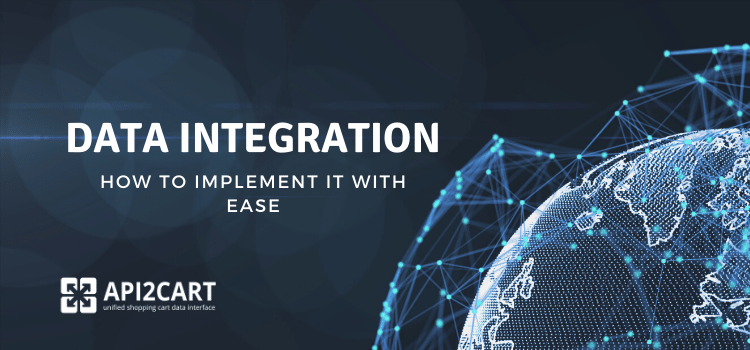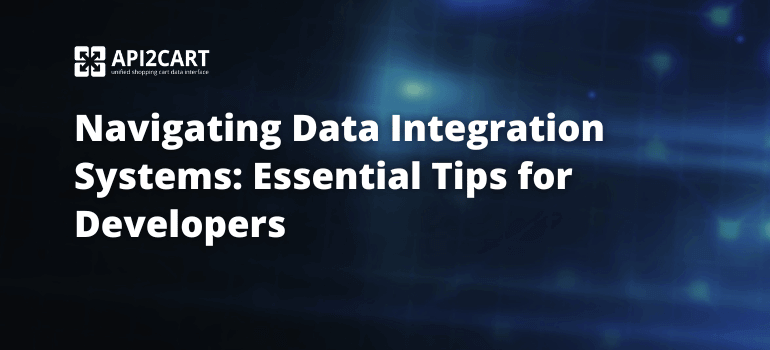
Today, developing solid eCommerce data integration is essential for SaaS app providers who want to expand their business and reach additional markets. Such a connection allows them to deal with the data from online shops such as products, orders, customers, etc. As a result, they are able to provide merchants with important features like managing orders, performing inventory updates, creating product catalogs, and many other functionalities.
In this post, you will discover data integration meaning and all the aspects of this term and a solution to integrate with eCommerce platforms easily.
What is eCommerce Data Integration?
Data integration is the combining of data from different source systems to create unified sets of information. The process of data integration is one of the most important elements of an organization's overall data management process, which is becoming increasingly important. The demand for sharing existing data continues to increase.
eCommerce data integration means the process of connecting your SaaS solution with the APIs of different shopping platforms and marketplaces. Such a connection allows you to easily extract data and deal with it following the demands of your clients. Data integration allows you to use information about products, orders, shipping, customers, inventories, and many other components of online shopping. The more connections you execute effectively, the easier it will be to expand your targeting niche and provide your services to additional clients.
Data Integration Example
Assume you provide inventory management solutions, for instance. By integrating your software with Shopify, you will be able to instantly retrieve the product and stock information, allowing you to provide better services to your clients that have businesses on this eCommerce platform. Without such a connection, you must manually extract information, which limits the speed and efficiency of your solutions on the market.
With a robust eCommerce data integration, you will be able to:
Grow your client base. You will have access to millions of prospective customers who use platforms like Shopify, Magento, Amazon, Zencart, OpenCart, WooCommerce, Lightspeed, and many others
Process data relating to products, inventories, orders, and so on
Create innovative features for your software
increase the income for your business
Data Integration Tools
Data integration methods can be applied across various organizational levels, from fully automated to manual processes. Data integration is typically accomplished with the following tools and techniques:
- Manual Integration Development or Common User Interface: There is no unified interpretation of the data. Users can access the information they need from the appropriate source systems.
- Application Software Integration: Each application must be able to support all the integration efforts.
- Middleware Integration: Moves the integration logic from an application to a new middleware layer.
- Uniform Data Access: The data remains in the source systems, and a set of views is defined to provide users with a unified view across the enterprise.
- Common Data Storage or Physical Data Integration: Creates a new system in which data from the source system is copied, stored, and managed independently of the original system.
The Difficulties of Data Integration
Of course, everybody would like to gain the advantages of data integration. Ultimately, information is the power that really can carry your company ahead and provide you with limitless opportunities for success. However, the process of integration is quite complex and time-consuming. Most SaaS software vendors find establishing this kind of integration to be a complicated task for the reasons listed below:
The complete integration process might take anything from 4 to 12 weeks.
Because development costs are pretty expensive, the price of a full implementation can go into thousands of dollars.
Dealing with platform changes is highly difficult and necessitates more development assistance, which demands additional money and effort.
Because each eCommerce platform has its unique API architecture, you'll need to collaborate with far more than one programmer, especially if you wish to build connections with various platforms. As a general rule, a programmer can only be skilled on two and no more than three platforms.
Manual integration with shopping platforms is a dangerous process that can lead to major security issues.
How to Easily Implement an Integration With Various eCommerce Platforms
No SaaS software provider wants to face the obstacles and security vulnerabilities listed above. The good news is that there's an easy solution to connect your SaaS software with numerous eCommerce platforms. Using API2Cart, you are no longer required to hire a team of programmers or spend many weeks on every integration because this unified API allows you to integrate with nearly 40 eCommerce platforms. Using this unified solution, you may not only avoid weeks of tedious work, but also increase your security, raise your efficiency, and save thousands of dollars in the long term.
API2Cart allows you to avoid the obstacles of data integration and establish safe connections with some of the most popular eCommerce platforms available. As an outcome, you will be able to handle data related to orders, products, categories, clients, and shipments using API2Cart API methods. In addition, you will be able to interact with an endless number of clients' stores' thanks to API2Cart's flexible infrastructure. The main advantage of API2Cart is that it allows you to connect with many eCommerce APIs simultaneously instead of doing additional work. Simply link your application to the API2Cart, which subsequently connects your SaaS solution to all major eCommerce platforms.
Interactive documentation is another benefit that should be mentioned. Programmers can try and see how everything works directly on our web page. To access the system, a 32-symbol API key is required for authentication. Speaking of uptime, it’s worth saying that our service is available on 99,9%.
Integrating your SaaS solution with eCommerce platforms is essential in 2022 and beyond, particularly if you want to gain a competitive advantage and beat your competition. The ideal way to build a solid and consistent eCommerce data integration is by using API2Cart. It will help you in staying ahead of the game and conquering any integration challenges. If you'd like to learn more about how API2Cart can help your SaaS software, please get in touch with us. We will gladly answer all your questions.



